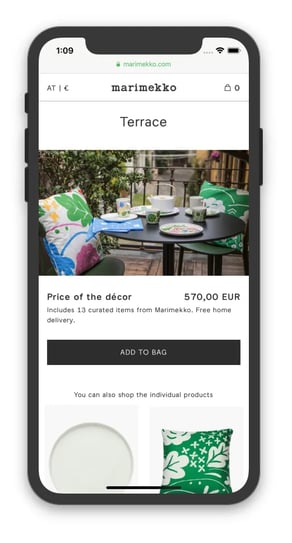What started in Milan as the Salone del Mobile in 1961—a fair to promote the best in Italian furniture design and accessories—has become one of the main global events in the design industry calendar. Now, the Salone is just one part of Milan Design Week, which takes over the entire city. Exhibitors from all facets of design and from all parts of the world descend on the city to display their most exciting innovations and newest creations to the world's top interior designers, stylists and press.
Key objectives
The goal of the Marimekko Shoppable Home was to make a splash by introducing a retail concept of the future and to pilot the new concept to investigate if and how it could be brought to Marimekko stores in the future.
The inspirational Marimekko home was set up in an apartment in Brera, Milan, during Design Week, from 9 - 14 April 2019 and was open to the public to experience. In the apartment, all items by Marimekko and Artek on display were available for purchase through marimekko.com and delivered to customers. For the Marimekko Shoppable Home, 9 bundles and 183 individual products were specially curated from Marimekko’s and Artek’s portfolios. The goal was to create a real home where someone could actually live in.
Marimekko also wanted to experiment with two different transactional payments in Milan: one physical, for consumers who wanted to bring home a special item available for purchase on-site, and one digital, for consumers who wanted to buy one or several bundles or individual products online. Without ever having to carry anything or worry about fitting all the items into their luggage.
I’ve been very happy with the collaboration. It’s been very natural to work with Columbia Road. Even with very scarce resources and a tight timeline, we were able to come up with fantastic solutions. Together, we created a buying experience that was seamless for every visitor and brought together both physical and digital spaces. This was truly a pioneering case for us, and we learned a lot.
Kari Härkönen, CDO, Marimekko
Our approach
We started by getting a deeper understanding of the context: what is a shoppable home? We also investigated what has been done in terms of event experiments and different ways of purchasing. At the same time, we defined three different buyer personas and their needs and designed customer journeys based on the personas, their goals and the payment process.
We focused on the key issues: what would be an inspirational and simple way for consumers to fill in their shopping basket when visiting the Marimekko Shoppable Home? We also got a few challenges from Marimekko: the payment process should be a natural part of the home with no large digital elements. We had to keep in mind that the simpler the solution, the better so that the visitor could make their purchase decisions and navigate the space easily.
Once the experience concept was set, we focused on usability, visuals and integrations with Marimekko’s existing ecommerce systems. Together with Marimekko, we decided to design and implement two digital experiences: one for the consumers in Milan who would walk inside the apartment and buy instantly and another one for the regular consumers, who were not able to visit the space physically, but would still be able to purchase the bundles or individual items online.

Impact
In terms of making a splash, the Marimekko Shoppable Home was a huge success. The concept was covered in the press worldwide, in media such as Elle Decoration China, Vogue Italy and AD Italy.
For Marimekko, the Milan Salone was also a proof of concept that delivered on expectations. Marimekko is now looking for new adaptations for the Shoppable Home in their physical stores and future events.
| 70% new, 30% returning | Marimekko Shoppable Home webstore visitors |
| 14 000 | Number of walk-ins who visited the Marimekko Shoppable Home |
| Sold out | Handpainted Oiva collectables |
Visit Marimekko Shoppable Home
The Data Handbook
How to use data to improve your customer journey and get better business outcomes in digital sales. Interviews, use cases, and deep-dives.
Get the book


